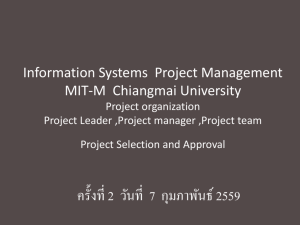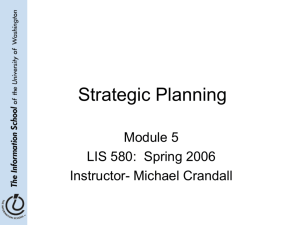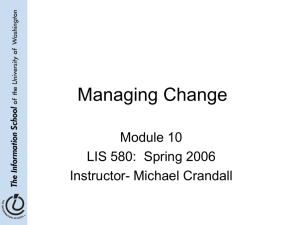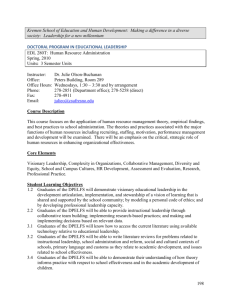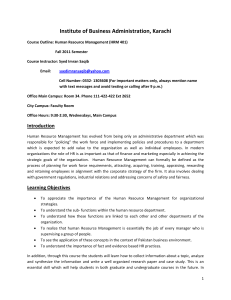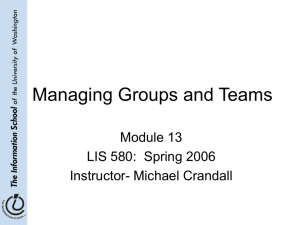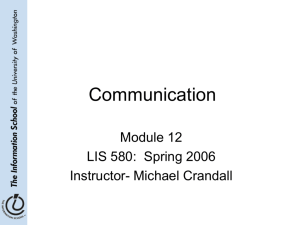Operations Management
advertisement
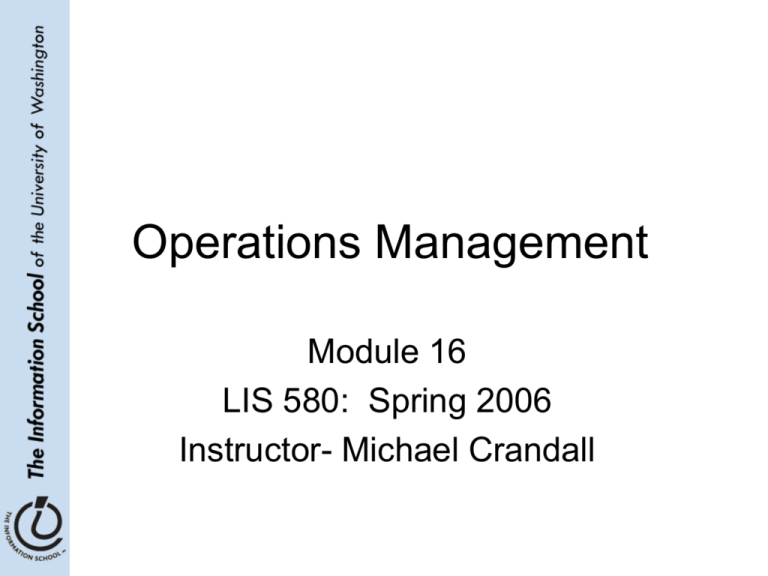
Operations Management Module 16 LIS 580: Spring 2006 Instructor- Michael Crandall Roadmap • • • • • • • • UPS and Seattle Public Library Production, facilities, and processes Operations planning and control Charting techniques Inventory management Quality control Management methods and systems Service management May 18, 2006 LIS580- Spring 2006 2 UPS/SPL • Any similarities between the two articles you read for today? • What impact does the streamlining of operations have on employees? • What technologies are key to the automation processes in these organizations? • How has UPS been able to squeeze further value out of its operations? • What lessons do companies like UPS have for service organizations like libraries? May 18, 2006 LIS580- Spring 2006 3 The Basics Of Operations Management • Operations Management – The process of managing the resources that are needed to produce an organization’s goods and services. – Operations managers focus on managing the “five Ps” of the firm’s operations: • People, plants, parts, processes, and planning and control systems. G.Dessler, 2003 May 18, 2006 LIS580- Spring 2006 4 The Production System • Input – A resource required for the manufacture of a product or service. • Conversion System – A production system that converts inputs (material and human resources) into outputs (products or services); also the production process or technology. • Output – A direct outcome (actual product or service) or indirect outcome (taxes, wages, salaries) of a production system. G.Dessler, 2003 May 18, 2006 LIS580- Spring 2006 5 The Basic Production System FIGURE 15–1 G.Dessler, 2003 May 18, 2006 LIS580- Spring 2006 6 Production System Components G.Dessler, 2003 May 18, 2006 LIS580- Spring 2006 7 Basic Types of Production Processes • Intermittent Production System – Production is performed on a start-and-stop basis, such as for the manufacture of made-to-order products. • Mass Production – A special type of intermittent production process using standardized methods and single-use machines to produce long runs of standardized items. G.Dessler, 2003 May 18, 2006 LIS580- Spring 2006 8 Basic Types of Production Processes (cont’d) • Mass Customization – Designing, producing, and delivering customized products to customers for at or near the cost and convenience of mass-produced items. – Mass customization combines high production volume with high product variety. – Elements of mass customization: • Modular product design • Modular process design • Agile supply networks G.Dessler, 2003 May 18, 2006 LIS580- Spring 2006 9 Basic Types of Production Processes (cont’d) • Continuous Production Processes – A production process, such as those used by chemical plants or refineries, that runs for very long periods without the start-and-stop behavior associated with intermittent production. – Enormous capital investments are required for highly automated facilities that use special-purpose equipment designed for high volumes of production and little or no variation in the type of outputs. G.Dessler, 2003 May 18, 2006 LIS580- Spring 2006 10 The Facility Location Decision • Decision Factors: – Customer convenience – Transportation costs – Labor costs and availability – Sources of supplies and raw materials – Owner preferences for specific locations – Government policies, rules, regulations and incentives – Site cost and availability G.Dessler, 2003 May 18, 2006 LIS580- Spring 2006 11 Facility and Production Layout • Facility Layout – The configuration of all the machines, employee workstations, storage areas, internal walls, and so forth that constitute the facility used to create a firm’s product or service. • Product Layout – A production system design in which every item to be produced follows the same sequence of operations from beginning to end, such as an assembly line. G.Dessler, 2003 May 18, 2006 LIS580- Spring 2006 12 Product Layout for Carwash Source: Everett Adam Jr. and Ronald Ebert, Production and Operations Management (Upper Saddle River, NJ: Prentice Hall, 1992), p. 254. May 18, 2006 LIS580- Spring 2006 FIGURE 15–2 G.Dessler, 2003 13 Facility and Production Layout (cont’d) • Process Layout – A production system design in which similar machines or functions are grouped together. • Fixed-Position Layout – A production system arrangement in which the product being built or produced stays at one location and the machines, workers, and tools required to build the product are brought to that location as needed, as for the building of ships or other bulky products. G.Dessler, 2003 May 18, 2006 LIS580- Spring 2006 14 Process Layout Source: Everett Adam Jr. and Ronald Ebert, Production and Operations Management (Upper Saddle River, NJ: Prentice Hall, 1992), p. 254. May 18, 2006 LIS580- Spring 2006 FIGURE 15–3 G.Dessler, 2003 15 Facility and Production Layout (cont’d) • Cellular Manufacturing Layout – A combination of process and product layouts, in which machines and personnel are grouped into cells containing all the tools and operations required to produce a particular product or family of products. G.Dessler, 2003 May 18, 2006 LIS580- Spring 2006 16 Improving Layouts by Moving to the Cellular Manufacturing Concept Source: Source: Barry Render and Jay Heizer, Principles of Operations Management, 2nd ed., © 1997. Reprinted by permission of Prentice Hall, Inc., Upper Saddle River, NJ. May 18, 2006 LIS580- Spring 2006 FIGURE 15–4 G.Dessler, 2003 17 Operations Planning And Control Techniques • Operations or Production Planning – The process of deciding what products to produce and where, when, and how to produce them. • Operations or Production Control – The process of ensuring that the specified production plans and schedules are being adhered to. G.Dessler, 2003 May 18, 2006 LIS580- Spring 2006 18 A Gantt Chart Gantt chart: a production scheduling chart (named after management pioneer Henry Gantt) that plots time on a horizontal scale and generally shows, for each product or project, the start-and-stop times of each operation. FIGURE 15–5 G.Dessler, 2003 May 18, 2006 LIS580- Spring 2006 19 Network Planning and Control Methods • Network Planning and Control methods – Ways of planning and controlling projects by graphically representing the projects’ steps and the timing and links between these steps. – PERT (program evaluation review technique) – CPM (critical path method) G.Dessler, 2003 May 18, 2006 LIS580- Spring 2006 20 Components of PERT Networks • Events – The specific accomplishments in a project, represented by circles in a PERT chart. • Activities – The time-consuming aspects of a project, represented by arrows in a PERT chart. • Critical Path – The sequence of events in a project that, in total, requires the most time to complete. G.Dessler, 2003 May 18, 2006 LIS580- Spring 2006 21 PERT Chart for Building a House FIGURE 15–6 G.Dessler, 2003 May 18, 2006 LIS580- Spring 2006 22 Example of a Computerized Network Planning Report FIGURE 15–7 G.Dessler, 2003 May 18, 2006 LIS580- Spring 2006 23 Inventory • Types of Inventory Items – Raw materials and purchased parts from outside suppliers. – Components: subassemblies that are awaiting final assembly. – Work in process: all materials or components on the production floor in various stages of production. – Finished goods: final products waiting for purchase or to be sent to customers. – Supplies: all items needed but that are not part of the finished product, such as paper clips, duplicating machine toner, and tools. G.Dessler, 2003 May 18, 2006 LIS580- Spring 2006 24 The Role of Inventory Management • Inventory Management – The process of ensuring that the firm has adequate inventories of all parts and supplies needed, within the constraint of minimizing total inventory costs. • Inventory Costs – Ordering (setup) costs – Acquisition costs – Holding (carrying) costs – Stockout costs G.Dessler, 2003 May 18, 2006 LIS580- Spring 2006 25 Inventory Costs • Ordering (Setup) Costs • Inventory-Holding (Carrying) Costs – The costs, usually fixed, of placing an order or setting up machines for a production run. • Acquisition Costs – All the costs associated with carrying parts or materials in inventory. • Stockout Costs – The total costs of all units bought to fill an order, usually varying with the size of the order. – The costs associated with running out of raw materials, parts, or finished-goods inventory. G.Dessler, 2003 May 18, 2006 LIS580- Spring 2006 26 Basic Inventory Management Systems • ABC Inventory Management • Inventory is divided into three dollar-volume categories—A, B, and C—with the A parts being the most active (largest dollar volume). – Inventory surveillance concentrates most on checking the A parts to guard against costly stockouts. – The idea is to focus most on the high-annualdollar-volume A inventory items, to a lesser extent on the B items, and even less on the C items. G.Dessler, 2003 May 18, 2006 LIS580- Spring 2006 27 Economic Order Quantity (EOQ) • Economic Order Quantity (EOQ) – An inventory management system based on a simple formula that is used to determine the most economical quantity to order so that the total of inventory and setup costs is minimized. – Assumptions: • • • • Constant per unit holding and ordering costs Constant withdrawals from inventory No discounts for large quantity orders Constant lead time for receipt of orders G.Dessler, 2003 May 18, 2006 LIS580- Spring 2006 28 The Economic Order Quantity Model FIGURE 15–8 G.Dessler, 2003 May 18, 2006 LIS580- Spring 2006 29 Controlling For Quality And Productivity • Quality – The extent to which a product or service is able to meet customer needs and expectations. • Customer’s needs are the basic standard for measuring quality • High quality does not have to mean high price. • ISO 9000 – The quality standards of the International Standards Organization. G.Dessler, 2003 May 18, 2006 LIS580- Spring 2006 30 Controlling For Quality And Productivity • Total Quality Management (TQM) – A specific organization-wide program that integrates all the functions and related processes of a business such that they are all aimed at maximizing customer satisfaction through ongoing improvements. – Also called: Continuous improvement, Zero defects, Six-Sigma, and Kaizen (Japan) • Malcolm Baldridge Award – A prize created in 1987 by the U.S. Department of Commerce to recognize outstanding achievement in quality control management. G.Dessler, 2003 May 18, 2006 LIS580- Spring 2006 31 Checklist 15.1 How to Win a Baldridge Award Is the company exhibiting senior executive leadership? Is the company obtaining quality information and analysis? Is the company engaging in strategic quality planning? Is the company developing its human resources? Is the company managing the entire quality process? How does the company measure operational results? Does the company exhibit a customer focus? G.Dessler, 2003 May 18, 2006 LIS580- Spring 2006 32 Quality Control Methods • Acceptance Sampling – a method of monitoring product quality that requires the inspection of only a small portion of the produced items. G.Dessler, 2003 May 18, 2006 LIS580- Spring 2006 33 Example of a Quality Control Chart FIGURE 15–9 G.Dessler, 2003 May 18, 2006 LIS580- Spring 2006 34 Commonly Used Tools for Problem Solving and Continuous Improvement Source: Adapted from Richard Chase and Nicholas Aquilero, Production and Operations Management, 6th ed. (Homewood, IL: Irwin, 1992), p. 197. May 18, 2006 LIS580- Spring 2006 FIGURE 15–10 G.Dessler, 2003 35 Fishbone Chart (or Cause-and-Effect Diagram) for Problems with Airline Customer Service FIGURE 15–11 G.Dessler, 2003 May 18, 2006 LIS580- Spring 2006 36 Pareto Analysis Chart Source: Jay Heizer and Barry Render, Operations Management, 6th ed. (Upper Saddle River, NJ: Prentice Hall, 2001), p. 182. Example 1. May 18, 2006 LIS580- Spring 2006 FIGURE 15–12 G.Dessler, 2003 37 Design for Manufacturability • Designing for Manufacturability (DFM) – Designing products with ease of manufacturing and quality in mind. DFM Goals: • Exhibit the desired level of quality and reliability. • Be designed in the least time with the least development cost. Make the quickest and smoothest transition into production. • Be produced and tested with the minimum cost in the minimum amount of time. • Satisfy customers’ needs and compete in the marketplace. G.Dessler, 2003 May 18, 2006 LIS580- Spring 2006 38 Design for Manufacturability (cont’d) • Concurrent Engineering – Designing products in multidisciplinary teams so that all departments involved in the product’s success contribute to its design. G.Dessler, 2003 May 18, 2006 LIS580- Spring 2006 39 Rapid Plant Assessment Rating Sheet Source: R. Eugene Goodson, “Reading A Plant—Fast,” Harvard Business Review, May 2002, pp. 108–9. May 18, 2006 LIS580- Spring 2006 FIGURE 15–13 G.Dessler, 2003 40 World-Class Operations Management Methods • Total Quality Management (TQM) • Just-In-Time (JIT) manufacturing • Computer-Aided Design and Manufacturing (CADCAM) • Flexible Manufacturing Systems (FMS) Computer-Integrated Manufacturing (CIM), Supply-Chain Management • Enterprise Resource Planning (ERP) G.Dessler, 2003 May 18, 2006 LIS580- Spring 2006 41 Just-In-Time (JIT) • Just-In-Time (JIT) – A production control method used to attain minimum inventory levels by ensuring delivery of materials and assemblies just when they are to be used. – A philosophy of lean or value-added manufacturing manufacturing that aims to optimize production processes by continuously reducing waste. – A management philosophy that assumes that any manufacturing process that does not add value to the product for the customer is wasteful. G.Dessler, 2003 May 18, 2006 LIS580- Spring 2006 42 Just-In-Time (JIT) (cont’d) • Seven Wastes and Their Solutions – Overproduction: reduce by producing only what is needed as it is needed. – Waiting: synchronize the workflow. – Transportation: minimize transport with better layouts. – Processing: “Why do we need this process at all?” – Stock: reduce inventories. – Motion: reduce wasted employee motions. – Defective products: improve quality to reduce rework. G.Dessler, 2003 May 18, 2006 LIS580- Spring 2006 43 Computer-Aided Design and Manufacturing • Computer-Aided Design (CAD) – A computerized process for designing new products, modifying existing ones, or simulating conditions that may affect the designs. • Computer-Aided Manufacturing (CAM) – A computerized process for planning and programming production processes and equipment. G.Dessler, 2003 May 18, 2006 LIS580- Spring 2006 44 Flexible Manufacturing Systems • Flexible Manufacturing System (FMS) – The organization of groups of production machines that are connected by automated materials-handling and transfer machines, and integrated into a computer system for the purpose of combining the benefits of made-to-order flexibility and massproduction efficiency. • Automation – The automatic operation of a system, process, or machine. G.Dessler, 2003 May 18, 2006 LIS580- Spring 2006 45 Computer-Integrated Manufacturing • Computer-Integrated Manufacturing (CIM) – The total integration of all productionrelated business activities through the use of computer systems. – Automation, JIT, flexible manufacturing, and CAD/CAM are integrated into one selfregulating production system. G.Dessler, 2003 May 18, 2006 LIS580- Spring 2006 46 The Elements of CIM Source: Barry Render and Jay Heizer, Principles of Operations Management, 2nd ed. © 1997. Reprinted by permission of Prentice Hall, Inc., Upper Saddle River, NJ. May 18, 2006 LIS580- Spring 2006 FIGURE 15–14 G.Dessler, 2003 47 Supply Chain Management • Supply Chain Management – The integration of the activities that procure materials, transform them into intermediate goods and final product, and deliver them to customers. G.Dessler, 2003 May 18, 2006 LIS580- Spring 2006 48 Trends in Supply Chain Management • Supplier Partnering – Choosing to do business with a limited number of suppliers, with the aim of building relationships that improve quality and reliability rather than just improve costs. • Channel assembly – Organizing the product assembly process so that the company doesn’t send finished products to its distribution channel partners, but instead sends the partners components and modules. Partners become an extension of the firm’s product assembly process. G.Dessler, 2003 May 18, 2006 LIS580- Spring 2006 49 Trends in Supply Chain Management (cont’d) • Channel Assembly – Organizing the product assembly process so that a company sends its distribution channel partners components and modules rather than finished products. The partners then become an extension of the firm’s product assembly process. • Internet Purchasing (e-Procurement) – Vendors interact with other firms via the Internet to accept, place and acknowledge orders via the Web. G.Dessler, 2003 May 18, 2006 LIS580- Spring 2006 50 The Supply Chain Source: Adapted from Jay Heizer and Barry Render, Operations Management (Upper Saddle River, NJ: Prentice Hall, 2001), p. 434. May 18, 2006 LIS580- Spring 2006 FIGURE 15–15 G.Dessler, 2003 51 Managing Services • Service Management – A total organization-wide approach that makes quality of service the business’s number one driving force. • Why Service Management Is Important – Service is a competitive advantage. – Bad service leads to lost customers. – Customer defections drain profits. G.Dessler, 2003 May 18, 2006 LIS580- Spring 2006 52 Managing Services (cont’d) • Moment of Truth – The instant when the customer comes into contact with any aspect of a business and, based on that contact, forms an opinion about the quality of the service or product. • Cycle of Service – Includes all of the moments of truth experienced by a typical customer, from first to last. G.Dessler, 2003 May 18, 2006 LIS580- Spring 2006 53 The Service Triangle (Karl Albrecht) Well-Conceived Service Strategy CustomerOriented Front-line People Customer-Friendly Systems G.Dessler, 2003 May 18, 2006 LIS580- Spring 2006 54 How to Implement a Service Management Program Step I: The Service Audit Step 2: Strategy Development Step 3: Education Step 4: Implementation Step 5: Maintenance— Making the Change Permanent G.Dessler, 2003 May 18, 2006 LIS580- Spring 2006 55 Next Time • Guest Lecturer: – Deborah Jacobs, Seattle Public Librarian – Read the Economic Benefits Assessment and come prepared to ask questions related to measurement, accountability and operations at SPL • Last class before your presentations • Make sure to turn in your papers by Tuesday midnight!!! May 18, 2006 LIS580- Spring 2006 56
